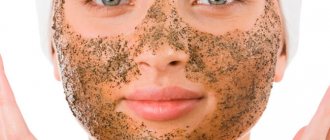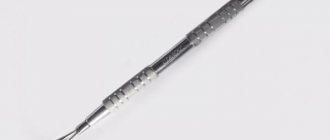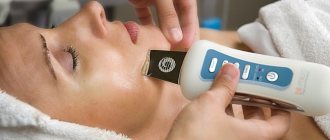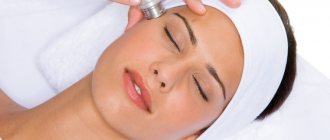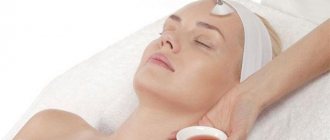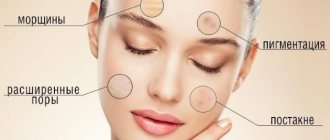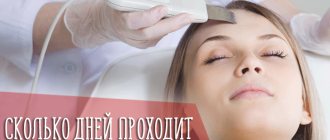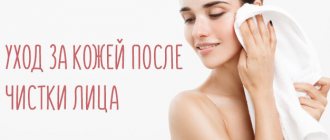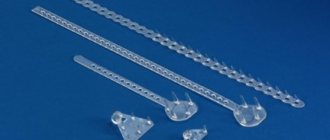How to do facial peeling at home ↑ (recipes)
Most often, peeling at home is carried out using scrubs, for example, coffee scrub. But to select the most suitable scrub composition, it is better to consult a dermatologist or cosmetologist; they will help determine the appropriate scrub composition to achieve optimal results and avoid allergic reactions.
You can prepare peeling masks yourself. I wrote about this in the article “Cleansing your face at home,” I recommend reading it. Fine sand, almond bran, crushed eggshells, semolina, coffee grounds, salt and others are suitable as “sandpaper”. They are mixed with olive oil, melted honey, cottage cheese or other suitable products.
But you can also use scrubs of so-called “industrial” origin, which I will discuss below. Scrubs are usually used once or twice a week.
You can also purchase devices for home peeling in special stores. I will list them later.
Some important tips regarding peeling.
- Peeling should be done no more than twice a week.
- Do not apply strong pressure to the skin.
- It is better to use light peelings with small crystals to avoid severe irritation on the skin.
- Peels are best applied to damp skin and avoid the areas around the eyes (the skin there is very thin and delicate).
Personally, I use factory peels. Although now I’m already learning how to prepare them myself. By the way, I'm going to try one of the salon peels. I will definitely share my experience, as well as before and after photos, with you in future articles. So I advise you to subscribe to blog updates and stay up to date with the latest news.
Salt peeling with baking soda at home
Mix salt and soda, taking 1 tsp each. from 1 tbsp. l. favorite cream. Apply to face and let work for 20 minutes. Rinse off with warm water. This salt peel can sting the skin. If the burning sensation is very strong, you need to stop the procedure and clean your face with water.
By the way, salt peeling can be done not only on the face, but also on the scalp. Read about this in our article “How to exfoliate the scalp with salt?”
Facial peeling with aspirin at home
Take regular pharmacy aspirin (3 tablets) and grind it. Add a little water and mix with 1 tsp. honey Apply to face and leave for 20 minutes. Then rinse with warm water. Aspirin peeling works well for problem skin.
Yogurt
Mix sugar and yogurt in equal proportions. Without waiting for the sugar to dissolve, apply to your face with massaging movements, hold for 15 minutes and rinse with water.
Fruit
Make a paste of 1/4 apple and 2-3 strawberries. Apply to face for 15-20 minutes, then rinse. Apply moisturizer.
Citric
Mix lemon juice and boiled water in equal proportions. Apply with a cotton pad in several steps. Good for aging skin, as well as for getting rid of age spots.
We recommend the article “Peeling with salicylic acid at home: recipes, before and after photos” on the topic of facial peels.
Mechanical skin cleaning at home
Despite the apparent complexity of mechanical facial cleansing, it is quite possible to do it at home, following certain rules. Almost all cosmetologists and dermatologists in their reviews categorically prohibit doing mechanical facial cleansing at home , and many people who suffer from problem skin often believe them, continuing to leave quite large amounts of money in beauty salons every month.
But few people think that it is quite possible to do this procedure yourself. The main condition for cleaning the face at home mechanically is to create sterility of the hands, face and instruments used. This can be achieved by carefully considering step-by-step cleaning and preparing disinfectants.
First, you need to
prepare a cleaning area equipped with a large magnifying mirror and a bright table lamp so that the skin is as visible as possible.
It is best to do this at a table, which needs to be covered in several layers of sterile gauze. Then you need to comb your hair back and secure it with a special bandage, then take care of thoroughly cleaning your hands with antibacterial soap, and then your face using soft gels, foams or any other means that are washed off with water. You need to wipe your facial skin with disposable paper towels or, even better, a piece of sterile bandage.
Afterwards, you need to prepare the skin for further cleansing by opening all the pores . This can be done using a so-called water bath, which involves steaming the facial skin over a pan of hot water for 6-12 minutes for oily skin, and 3-5 minutes for normal skin.
Instead of plain water, it is advisable to use various herbal decoctions that have a mild sedative and anti-inflammatory effect (calendula, chamomile, etc.) or simply drop a few drops of lemon essential oil, eucalyptus or tea tree oil into the pan. Instead of steaming, special warming masks are also used, but they open the pores a little worse.
After preparing your facial skin, you need to wash your hands again with some antibacterial agent or simple ethyl alcohol.
You need to cleanse your face, starting with the cleanest areas, and slowly move towards dirtier areas (usually from the periphery to the middle of the face). Some cosmetologists in reviews recommend wrapping your fingers in sterile disposable napkins , which need to be replaced after every few squeezed out comedones, but if you have short nails, you can simply wash your hands periodically with alcohol.
You need to apply pressure on comedones very carefully, “pumping” their contents towards the middle. It is not advisable to use a Vidal needle, Uno spoon or other special devices when cleansing your face at home. There is no need to try to clean all the pores, as this is almost impossible. You need to pay attention to the most contaminated part of the face, and after cleaning, be sure to wash thoroughly again with antibacterial soap and apply a soothing cream to the body, which has the effect of narrowing pores.
Contraindications to mechanical facial cleansing
Since mechanical facial cleansing is a rather traumatic process for the skin, there are a number of contraindications for its implementation, namely:
- Allergic dermatitis at the acute stage.
- The presence of any infectious skin diseases.
- Tendency to fragility of blood vessels on the face and rosacea.
- Eczema, psoriasis and similar diseases associated with the presence of areas with peeling and disruption of the surface layer of the skin.
- Tendency to the appearance of keloid scars from any damage to the skin.
- Severely dry facial skin.
- Vegetative-vascular dystonia, bronchial asthma and other cerebrovascular accidents.
- The presence of large convex moles and other formations on the face that can be damaged during cleaning.
Combined facial cleansing
One of the most effective approaches to caring for oily and problematic skin is a combination of ultrasonic and mechanical cleaning, which makes it possible to achieve more effective cleansing. You can apply ultrasound to the skin both before and after mechanical cleansing. In the latter case, the process of subsequent cleansing of the pores is easier , and in the former, you can soothe the skin and “fix” the effect of mechanical cleaning with the help of anti-inflammatory professional drugs, the penetration of which into the skin is improved thanks to ultrasound.
Unlike mechanical cleaning, the result of ultrasonic cleaning will not depend on the qualifications of the master. And if it is best to trust the skin for manual cleaning only to a dermatologist, then any cosmetologist can handle facial cleansing using ultrasound . In addition, there are also special devices for carrying out this procedure at home, which make it possible to clean the pores yourself.
Methodology
The combined cleaning procedure takes about two hours on average. During this time, I perform a number of cosmetic manipulations on the patient’s face, which can be roughly divided into three stages:
- preparing the skin for further actions;
- actual cleaning (manually and using equipment);
- final care procedures.
Preparation
In order for the procedure to go without complications and give the best possible effect, the patient must adhere to a number of rules. You need to start preparing a week before the session. Avoid visiting beaches and solariums, do not go to the sauna, do not eat spicy, fried or fatty foods.
If you are prone to allergic reactions, you need to monitor your diet even more carefully. Try not to eat foods that are strong allergens, even if you have not had any cases of intolerance so far.
Execution steps
First, I analyze the patient’s skin and select products that are suitable for him, with the help of which I remove surface impurities and cosmetics. Then I do scrubbing - it helps remove dead skin cells and open pores. Then I manually perform a small facial massage to relax the muscles.
Next comes the stage of manual cleaning. It all depends on the characteristics and condition of the patient’s skin. In general, I treat the skin with hot steam for several minutes to open the pores even more and the stratum corneum becomes softer.
If the vessels lie close to the surface or the skin is too thin and sensitive, steam is excluded. In this case, special moisturizing masks are used. I apply the drug to the face and cover it with a film on top, as a result the same effect is achieved as from steaming, but the dermis is less injured.
Before I begin manual cleaning, I treat problem areas with an antiseptic. After this, I use special tools, such as a Uno spoon, with which I tidy up the dirty pores. In the most difficult cases, when the devices fail, I clean the pores manually. This is an unpleasant process and may leave marks on the skin, so I save it as a last resort. In total, this step takes about ten minutes. If the pores begin to narrow during the procedure, I repeat the steam treatment.
Next comes the time for ultrasonic cleaning. I do it using a special gel that improves the conductivity of the waves, moving from the edges to the center. At the same time, I monitor the skin’s reaction. If red spots begin to appear in any area, I stop working on it.
Finally, I apply a soothing anti-inflammatory mask that helps tighten pores. At the very end I apply a nourishing cream according to my skin type.
Skin care and recovery
The recovery period after combined facial cleansing takes from three to seven days, depending on the condition of the skin and individual characteristics.
- For the first day after the procedure, I do not recommend washing your face and immediately going outside. Especially if it's cold or windy there.
- For three to seven days you should not use scrubs and decorative cosmetics, as well as play sports or undergo any physical activity that can cause sweating.
- For the entire first week after the session, you should not visit saunas and solariums, or sunbathe on the beach or generally be exposed to direct sunlight.
During the rehabilitation period, the face should be treated with mild antiseptics that will not dry out the skin. You can use ointments based on calendula or chamomile extracts, or make cool sterile compresses. This will help reduce the severity of side effects, reduce inflammation and swelling.
In order for the effect of the procedure to last as long as possible, you need to take regular care of your face. Naturally, you should start only after the skin has completely healed. Use pore-tightening toners and moisturizers.
Precautionary measures
Before carrying out cleansing, you should familiarize yourself with the existing restrictions and possible negative consequences of cleansing.
Contraindications
Identifying contraindications is one of the important tasks when choosing a cleansing procedure. Ultrasonic cleaning is harmful when:
- pregnancy and breastfeeding;
- oncology and neoplasms in the affected area;
- rosacea;
- purulent inflamed elements on the face;
- arrhythmias;
- have pacemakers.
Ultrasonic peeling cannot be performed on inflamed and weakened skin, immediately after chemical peeling, mechanical cleansing or surgery. An ultrasound will worsen the situation and delay the recovery process.
Fever and weakness in the patient also prevent cleaning. You can resort to it after strengthening the body and the disappearance of unpleasant symptoms.
It is not recommended to use hardware techniques after biorevitalization, injection of fillers and Botox. Physical factors and heat will accelerate the biodegradation of hyaluronic acid.
Side effects
Violation of the procedure technology, prolonged exposure to ultrasound on sensitive areas contribute to the development of such unpleasant consequences as:
- redness of the skin;
- soreness, inflammation;
- local burns;
- severe peeling of the epidermis, feeling of tightness;
- swelling;
- increase in acne lesions.
You can avoid the development of side effects by seeking the help of only an experienced and qualified cosmetologist.
Varieties
It is best to choose one or another procedure in tandem with a cosmetologist. A professional will assess the condition of the skin, existing problems and offer his own options. Types of cleansing differ in technology, indications for implementation, and degree of impact on the skin.
Mechanical
Most often, this method refers to a manual (manual) method of eliminating comedones and pimples - squeezing them out using a Vidal needle, strainer or Uno spoon.
Some experts differentiate the concepts: mechanical cleaning is called cleaning, which involves the use of sterile instruments, and classical manual cleaning is the one where the cosmetologist works exclusively with his hands.
Any of the methods is suitable for the owner of an oily, combination epidermis with clogged pores and abundantly covered with blackheads, pimples, and acne.
Mechanical methods of facial cleansing also include brushing. Another name is brossage. The keratinized particles of the dermis are exfoliated using special brushes.
Ultrasonic
One of the least painful and traumatic cleaning methods. The cosmetologist acts on the skin with a special device that emits ultrasonic waves. As a result, the face is cleansed of sebaceous plugs, blackheads, etc. An additional effect is micromassage, which stimulates blood circulation and metabolism. The ultrasound method is suitable for girls with normal skin type. It does not act aggressively, so it will not cope with serious problems.
Combined
Combines 2 types of cleaning at once: manual and ultrasonic. The first is used on problem areas with blackheads, milia and other defects. Ultrasound cleanses the entire surface of the face, refreshing the skin, improving its color and texture. The method is suitable for almost all women, with the exception of those whose skin is too dry.
Vacuum
It occurs using special equipment with a suction cup that creates a vacuum that pushes all impurities to the surface of the skin. Has a slight lifting effect. The procedure is suitable for owners of any type of skin, but it may not be effective for oily and problematic dermis.
Laser
It is considered the most expensive and quite aggressive cleaning. The laser beam evaporates (burns) problem areas, stimulating epidermal cells to renew. In place of the previous layer, a new, smoother, cleaner, even, uniform in color is formed. The technique is indicated for ridding the face of pigmentation, wrinkles, as well as increased greasiness, comedones and other problems characteristic of oily, problematic and combination types of dermis.
Atraumatic (chemical)
For this cleansing, the doctor uses special acid-based preparations that gently exfoliate the outer layer of the skin, cleanse it of impurities, and even out the tone and texture of the face.
The procedure is often called chemical peeling. The method is suitable for owners of any type of epidermis. The difference is in the composition of the product.
There is also another dry cleaning method that uses phytic acid. The method is called Hollywood and is recommended for women with dry, aging, oily skin. This option is also used for sensitive skin.
Galvanic
Other names are disincrustation, galvanotherapy or galvanophoresis. During the procedure, a special solution is applied to the skin. In order for the drug to better penetrate the epidermis, the cosmetologist applies weak electrical impulses to the patient’s face. This cleansing helps normalize the functioning of the sebaceous glands, dissolve impurities, and soften comedones. However, the method is not suitable for girls with dry, thin skin.
The average cost of different types of facial cleansing in Moscow is from 2,000 to 4,000 rubles. You can find it both cheaper and more expensive. The price of the laser method (depending on the complexity of the situation) reaches 12–16 thousand rubles, and this is not the limit either. How much any procedure costs depends on the location of the clinic, the qualifications of the doctor, the size of the treated area, etc.
Benefits of professional cleaning
Professional facial cleansing is more effective than home cleansing and produces long-lasting positive results. It allows you to eliminate virtually any problem at any stage and get rid of several types of contaminants in a complex at once, which is not always possible to achieve when performing the procedure yourself. In addition, professional exposure contributes to:
- Regulating the functioning of the sebaceous glands.
- Normalization of local metabolic processes.
- Eliminate blackheads, pimples and acne.
- Reduce age spots and scars;
- Strengthening cell regeneration.
- Improving complexion.
- Preventing the formation of wrinkles.
At the same time, the risks of possible complications and negative reactions of the body to the intervention are reduced to zero.
If dermatological problems are observed in a teenager, cleaning yourself is strictly prohibited. At home, it is very easy to injure delicate skin, and this will ultimately only lead to a worsening of the current situation. The specialist will assess the problem and select the appropriate technique, taking into account all the features.
Video: cosmetologist on the rules of cleansing facial skin
How to perform hardware facial cleansing at home
Hardware facial cleansing at home is performed using special devices designed for independent use. They are weaker and show less effect than their professional counterparts, but they are guaranteed not to harm the epidermis when used by a person who does not have a specialized education.
House cleaning is carried out according to the instructions provided with the purchased device. In the next 2-3 days after the procedure, you should carefully care for your skin. This will avoid inflammation, redness, and injury.
If hardware cleansing is accompanied by pain or discomfort, change the mode to a weaker one or abandon the procedure. A home session using non-professional devices should not cause discomfort.
Contraindications
Chemical cleaning is an aggressive procedure; before carrying out it, it is advisable to familiarize yourself with the full list of contraindications. Among them:
- Lactation and pregnancy.
- Exacerbation of chronic pathologies.
- Viral and bacterial diseases (flu, sore throat, ARVI), fever.
- Skin hypersensitivity, tendency to scar formation.
- Nervous disorders.
- Oncology.
- High pressure.
- Diabetes.
- Individual intolerance to the acid used for peeling.
- Skin diseases, open wounds and inflammation.
In addition to the absolute contraindications given above, there is an additional number of restrictions under which the procedure is permissible, but not recommended. Among them:
- Period of menstruation.
- Moles.
- Age up to 18 years.
- High skin sensitivity.
Types of facial cleansing
Mechanical
Despite its apparent simplicity, the method is quite effective. It is carried out without the use of additional means, using your fingers.
Essentially, this is squeezing out dirt in compliance with cosmetic and hygienic safety rules. The facial skin is steamed first, which opens the pores, making them much easier to cleanse. Acne is removed using fingers wrapped in sterile wipes.
Mechanical facial cleansing is stressful for the skin. Therefore, after the procedure, soothing masks are applied to the face. The use of tightening agents is also indicated. However, facial redness may persist for 2-3 days.
When cleaning, you can use the so-called Uno spoon. One side of this simple device is a strainer with multiple holes located on it. The second side has only one hole in the middle.
The strainer is designed to remove fat and dead horny scales. The part with a hole in the middle is used to squeeze out pimples. The spoon is positioned so that the pimple is in the center, after which the contents of the pimple are squeezed out with light pressure.
Another device used in the mechanical procedure is the Vidal needle. One side of the object is equipped with a needle to puncture the pimple at its thinnest point. This helps to squeeze it out with minimal pain. The second side is a spoon with one hole. It is pressed on the pimple to remove the contents.
Vacuum facial cleansing
This method of facial cleansing is more advanced and allows for thorough cleansing of the skin. To carry out the procedure, special vacuum equipment with a nozzle for pumping air under negative pressure is used. Under its influence, contaminants are literally “sucked” to the surface.
The session is not recommended before going out or an important event, since the redness of the face will last at least until the next morning. To soothe irritated skin, it is recommended to apply a special mask. Vacuum cleaning is especially effective in combination with lymphatic drainage massage.
Ultrasonic
Today it is the most productive. Sometimes this cleaning is called ultrasonic peeling. This is a very effective method, although the impact is limited to the superficial layers of the skin, making the procedure less traumatic. It can be used both separately and in combination with other types of cleansing.
First, special products are applied to the face to loosen the skin and comedones - disinfectants. These are gels or lotions containing fruit acids.
During the session, a special device with a spatula-shaped attachment is used. Through it, an ultrasonic acoustic wave is supplied to the surface of the skin, under the influence of which vibration massage is performed at the cellular level.
High-frequency vibrations destroy the pores of the skin, as a result they are easily cleaned. The effect of ultrasound helps to evacuate dead skin particles, eliminate acne, and smooth out wrinkles.
Chemical
This type of facial cleansing is sometimes confused with a chemical peel. However, these are completely different procedures. Peeling involves fairly harsh treatment of the skin using aggressive drugs that help remove the old layer.
During dry cleaning, there is virtually no physical impact on the face. First, a special mixture is applied to the skin, after which the cleansing process itself begins with the help of a more caustic composition. The result is heating of the skin, softening and removing fat and other impurities. At the final stage, a soft soothing mask is applied to the skin.
Depending on the substance used, chemical cleaning is divided into drug and enzymatic. The first uses oleic, malic, citric, lactic or glycolic acid. In the second procedure, the procedure is carried out using enzymes: papain and bromelain.
What is manual facial cleansing?
Manual facial cleansing involves squeezing out acne and blackheads by a master. The procedure is highly effective, but is quite painful and can be traumatic. Manual facial cleansing is not performed if the pain threshold is low, or if there are inflammatory processes in the epidermis.
The technique involves the initial steaming of facial pores, resulting in softening of the epidermis. Then the specialist proceeds directly to eliminating acne and blackheads. Afterwards, the face is treated with a disinfectant that degreases and tightens pores.
Manual cleaning is performed when deep cleansing is necessary, as well as when there are problems that conventional methods cannot cope with (chemicals, laser, etc.).
However, the procedure is not possible if there are inflammations, herpes, ulcers on the face, or if the skin is extremely dry. Also, you should not remove pimples and blackheads manually if you have diseases such as rosacea, demodicosis, etc. If you are prone to allergies, as well as hypersensitivity, manual cleaning is contraindicated.
The biggest disadvantage of the procedure is the painful sensations that will need to be endured throughout the entire work of the master. Also, after manual cleansing, marks may remain that last for several days. On average, manual cleaning lasts for one hour. For some time, until the condition of the epidermis is completely restored, you will have to stop using decorative cosmetics.
Most often, the procedure uses a Uno spoon, which can also be used at home.
Before cleansing, all makeup is removed, followed by a light exfoliation. After peeling, the skin is steamed with thin jets of steam or thermal heating gel. Then proceed directly to cleansing the facial skin using the manual method.
Remember that any type of cosmetic facial cleansing must be pre-approved by a specialist. For each specific case, face type and skin characteristics, a specific set of procedures is selected, aimed at both cleansing the skin and minimizing the risk of injury.
Indications and contraindications
Indications for mechanical cleaning are as follows:
- the presence of blackheads and comedones;
- enlarged, contaminated pores;
- acne, pimples, acne (azelaine peeling also works well for these problems);
- wen and millet (milium);
- uneven, dull complexion;
- decreased skin tone, sagging (myostimulation procedure can help).
At the same time, there are a number of contraindications:
- acute forms of dermatitis;
- eczema;
- herpes;
- allergic reactions;
- menstruation;
- fragile vessels;
- severe dry skin;
- boils on the face;
- very sensitive skin prone to inflammation;
- hypertension;
- bronchial asthma;
- blood diseases.
Cleaning your face at home
When cleaning at home, the surface layer of the skin is first cleaned - makeup is removed with tonic or milk, and then peeling is carried out. To steam the skin (and, as a result, open the pores), a steam bath is done. All you need to do is boil water and hold your face over it. In order for this to have an effect, you need to cover yourself with a terry towel, which will hang down, covering the edges of the saucepan, for 10-15 minutes. It will be great if you steam the skin over a decoction of herbs.
For oily skin, a decoction of chamomile and horsetail is suitable, which will dry out the skin; for dry and problematic skin - from rosemary, yarrow and wormwood, it has an anti-inflammatory effect and will eliminate peeling. During this procedure, steam will settle on the face, due to which there will be a lot of moisture on the skin; it must be carefully blotted with a dry towel.
And then you can start cleaning directly. It is important that all tools used are clean, including your hands. For mechanical cleaning, fingers should be wrapped in bandages or napkins soaked in salicylic alcohol - this will prevent injury to the skin and avoid infection. After which all contaminants are simply squeezed out of the pores.
At the end of this procedure, the pores must be narrowed. To do this, use a special pigment-constricting lotion or lemon juice diluted with water.
For those with normal or dry skin, there is no point in cleaning more often, once every two or even three months. But those who have oily skin prone to inflammation will have to cleanse at least two to three times a month.
Facial cleansing by a cosmetologist * Before and after with photos, hardware, deep, chemical, mechanical
» Beauty and care » Facial cleansing by a cosmetologist - before and after photos
Today there are many cosmetic procedures that can solve almost any problem, as evidenced by the photos before and after facial cleansing by a cosmetologist, which are publicly available. The range of services provided is so wide that it is difficult for an ordinary person to make the right choice. Cosmetologists are called upon to help with this and will select the right options.
Types of cleanings and who they are suitable for
Gone are the days when care consisted of steaming the dermis, squeezing out pimples and applying primitive compositions for masks. Cosmetology does not stand still, and therefore today this area amazes with the variety of procedures performed. Among the main types are:
- mechanical;
- chemical;
- ultrasonic;
- vacuum;
- laser;
- disincrustation.
Each of the listed techniques should be carried out in a salon setting, and before the session, be sure to consult a doctor.
It is he who, based on the condition of the patient’s epithelium, age, characteristics, existing problems, will tell you what type of procedure will be required.
Although all methods have a common goal - cleansing, they differ from each other in the method of implementation, the devices or compositions used, and indications.
So, they are recommended for people with the following problems:
- black dots;
- acne;
- acne;
- impaired secretion of the sebaceous glands;
- loss of turgor;
- deterioration of dermis tone;
- lethargy, aging.
After cleaning by a cosmetologist, as the photos show, the face is noticeably transformed: the color becomes healthy, the epidermis becomes elastic, clean, pores narrow, comedones are eliminated, and there is no trace of fine wrinkles.
Mechanical cleaning
This cleansing procedure is characterized by the use of special tools or devices.
It often causes discomfort, but remains one of the most effective procedures, since it reaches the middle layers of the dermis, cleansing “from the inside.”
The photo shows that after the cosmetologist’s actions, swelling remains, redness appears, and the appearance becomes painful. But this is quite normal, and most importantly, a temporary effect that, with proper care, will disappear after 2-3 days.
Dry cleaning
In this case, no mechanical impact is performed; peeling is carried out using alginate compounds and acids (often fruit), which penetrate the epidermis, breaking down toxic substances. Photos after chemical cleansing of the face show that such cleansing also leaves its mark on the face: redness or peeling (as in the photo).
Attention! The recovery period lasts from 5 to 10 days, during this time it is forbidden to use decorative cosmetics and sunbathe. You should use sunscreen before going outside
Ultrasonic cleaning
Ultrasonic facial cleansing is an innovation in the field of beauty with a number of advantages:
- painless;
- carried out without the use of tools;
- harmless;
- suitable for everyone.
Cleansing occurs under the influence of high-frequency ultrasound, the vibrations of which “get” dirt out of the cells. Therefore, this method does not lead to complications and has no negative consequences.
Vacuum cleaning
Hardware cleansing is similar to the previous type, since it also pulls out excess dirt and sebum from the pores. The photo of the face after hardware cleaning shows the result - a decrease in sebaceous plugs, an improvement in complexion, the epithelium after the intervention of a cosmetologist becomes dull, and the photo also shows that the relief is leveled.
Preparation
Cleaning is preceded by preparation of the skin, consisting of simple hygiene rules and some restrictive measures.
Basic procedure
The epithelium before and after the facial cleansing procedure is strikingly different; in order to know which cleansing will have certain consequences, it is important to understand the methods of facial treatment
Disincrustation (galvanic cleaning)
The galvanic current generated by a special device interacts with the pre-treated dermis. A polarizing alkaline composition is applied to it, which, under the influence of a microcurrent, penetrates into the tissue, breaking down dirt. A soap mixture is formed on the surface from a solution with the contents of the pores, which is removed by a cosmetologist during the session.
It is important to know! Despite the scary word “current”, galvanic cleaning is a gentle procedure recommended even for people with thin sensitive epithelium
What is vacuum facial cleansing?
Vacuum facial cleansing is performed using a device with a vacuum, which allows you to eliminate excess sebaceous secretions from the skin, as well as dirt accumulated in the pores. The procedure increases blood circulation, which improves complexion.
facial cleansing before and after photo
After the procedure, the face acquires a matte shine, contours are smoothed and swelling disappears. You should first consult with a dermatologist to determine if you have any contraindications. Vacuum cleansing is considered one of the most painless and safe cosmetic procedures. Most often, vacuum cleaning is used for oily or combination skin.
The vacuum copes well with hard-to-reach areas that cannot always be treated with mechanical cleaning. These are areas such as the wings of the nose, chin, etc.
Contraindications to the procedure are a tendency to culerosis (dilation and fragility of blood vessels and capillaries), as well as dry skin. The procedure can be carried out as needed, since the recovery time in this case is minimal.
